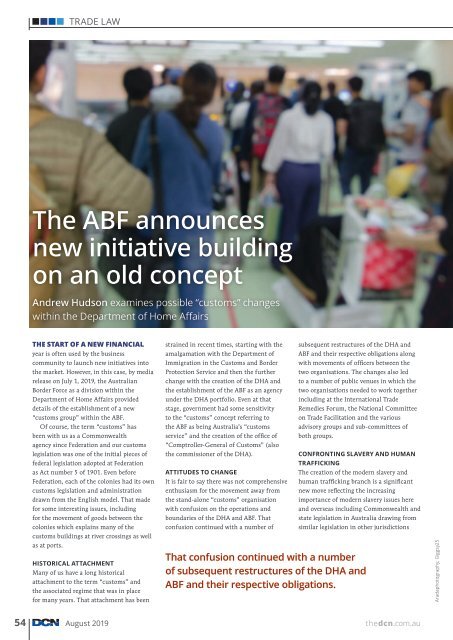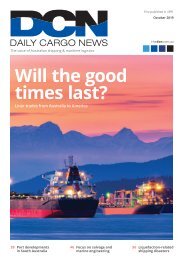DCN AUGUST Edition 2019
You also want an ePaper? Increase the reach of your titles
YUMPU automatically turns print PDFs into web optimized ePapers that Google loves.
TRADE LAW<br />
The ABF announces<br />
new initiative building<br />
on an old concept<br />
Andrew Hudson examines possible “customs” changes<br />
within the Department of Home Affairs<br />
THE START OF A NEW FINANCIAL<br />
year is often used by the business<br />
community to launch new initiatives into<br />
the market. However, in this case, by media<br />
release on July 1, <strong>2019</strong>, the Australian<br />
Border Force as a division within the<br />
Department of Home Affairs provided<br />
details of the establishment of a new<br />
“customs group” within the ABF.<br />
Of course, the term “customs” has<br />
been with us as a Commonwealth<br />
agency since Federation and our customs<br />
legislation was one of the initial pieces of<br />
federal legislation adopted at Federation<br />
as Act number 5 of 1901. Even before<br />
Federation, each of the colonies had its own<br />
customs legislation and administration<br />
drawn from the English model. That made<br />
for some interesting issues, including<br />
for the movement of goods between the<br />
colonies which explains many of the<br />
customs buildings at river crossings as well<br />
as at ports.<br />
HISTORICAL ATTACHMENT<br />
Many of us have a long historical<br />
attachment to the term “customs” and<br />
the associated regime that was in place<br />
for many years. That attachment has been<br />
strained in recent times, starting with the<br />
amalgamation with the Department of<br />
Immigration in the Customs and Border<br />
Protection Service and then the further<br />
change with the creation of the DHA and<br />
the establishment of the ABF as an agency<br />
under the DHA portfolio. Even at that<br />
stage, government had some sensitivity<br />
to the “customs” concept referring to<br />
the ABF as being Australia’s “customs<br />
service” and the creation of the office of<br />
“Comptroller-General of Customs” (also<br />
the commissioner of the DHA).<br />
ATTITUDES TO CHANGE<br />
It is fair to say there was not comprehensive<br />
enthusiasm for the movement away from<br />
the stand-alone “customs” organisation<br />
with confusion on the operations and<br />
boundaries of the DHA and ABF. That<br />
confusion continued with a number of<br />
subsequent restructures of the DHA and<br />
ABF and their respective obligations along<br />
with movements of officers between the<br />
two organisations. The changes also led<br />
to a number of public venues in which the<br />
two organisations needed to work together<br />
including at the International Trade<br />
Remedies Forum, the National Committee<br />
on Trade Facilitation and the various<br />
advisory groups and sub-committees of<br />
both groups.<br />
CONFRONTING SLAVERY AND HUMAN<br />
TRAFFICKING<br />
The creation of the modern slavery and<br />
human trafficking branch is a significant<br />
new move reflecting the increasing<br />
importance of modern slavery issues here<br />
and overseas including Commonwealth and<br />
state legislation in Australia drawing from<br />
similar legislation in other jurisdictions<br />
That confusion continued with a number<br />
of subsequent restructures of the DHA and<br />
ABF and their respective obligations.<br />
Aradaphotography; Giggsy25<br />
54 August <strong>2019</strong><br />
thedcn.com.au
















